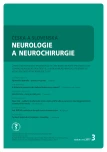Signifikantní edém mozku u neprasklé arteriovenózní malformace – kazuistika
Authors:
J. Hanuška; J. Klener
Authors‘ workplace:
Department of Neurosurgery, Na Homolce Hospital, Prague
Published in:
Cesk Slov Neurol N 2017; 80/113(3): 350-352
Category:
Case Report
doi:
https://doi.org/10.14735/amcsnn2017350
Overview
Perinidální edém u arteriovenózních malformací (AVM) bývá spojován s předchozím krvácením. Zřídka jej nacházíme u neprasklých malformací, kde může být příčinou vzniku epileptických záchvatů či neurologického deficitu. V naší kazuistice prezentujeme případ pacienta s relativně malou arteriovenózní malformací v levém frontálním laloku obklopenou výrazným edémem mozku, u kterého došlo ke generalizovanému epileptickému záchvatu. Mozková angiografie a vyšetření magnetickou rezonancí ukázaly abnormitu odvodné drenážní žíly, což některými autory bývá považováno za etiologický faktor vzniku perinidálního edému u neprasklých AVM. Pacient podstoupil mikrochirurgickou totální resekci AVM s nekomplikovaným pooperačním průběhem.
Klíčová slova:
arteriovenózní malformace – edém mozku – neprasklý
Autoři deklarují, že v souvislosti s předmětem studie nemají žádné komerční zájmy.
Redakční rada potvrzuje, že rukopis práce splnil ICMJE kritéria pro publikace zasílané do biomedicínských časopisů.
Sources
1. Abecassis IJ, Xu DS, Batjer HH, et al. Natural history of brain arteriovenous malformations: a systematic review. Neurosurg Focus 2014;37(3):E7. doi: 10.3171/ 2014.6.FOCUS14250.
2. Berman MF, Sciacca RR, Pile-Spellman J, et al. The epidemiology of brain arteriovenous malformations. Neurosurgery 2000;47(2):389–96.
3. Stapf C, Mohr JP, Pile-Spellman J, et al. Epidemiology and natural history of arteriovenous malformations. Neurosurg Focus 2001;11(5):e1. doi: 10.3171/ foc.2001.11.5.2.
4. Tong X, Wu J, Lin F, et al. The effect of age, sex, and lesion location on initial presentation in patients with brain arteriovenous malformations. World Neurosurg 2015; 87:598–606. doi: 10.1016/ j.wneu.2015.10.060.
5. Darsaut TE, Magro E, Gentric JC, et al. Treatment of brain AVMs (TOBAS): study protocol for a pragmatic randomized controlled trial. Trials 2015;16:497. doi: 10.1186/ s13063-015-1019-0.
6. Plasencia AR, Santillan A. Embolization and radiosurgery for arteriovenous malformations. Surg Neurol Int 2012;3(Suppl 2):90–104. doi: 10.4103/ 2152-7806.95420.
7. Hartmann A, Mast H, Mohr JP, et al. Determinants of staged endovascular and surgical treatment outcomeof brain arteriovenous malformations. Stroke 2005;36(11): 2431–5. doi: 10.1161/ 01.STR.0000185723.98111.75.
8. Kim BS, Sarma D, Lee SK, et al. Brain edema associated with unruptured brain arteriovenous malformations. Neuroradiology 2009;51(5):327–35. doi: 10.1007/ s00234-009-0500-4.
9. Shimizu S, Miyasaka Y, Tanaka R, et al. Pial arteriovenous malformation with massive perinidal edema. Neurol Res 1998;(3):249–52.
10. Kumar AJ, Viñuela F, Fox AJ, et al. Unruptured intracranial arteriovenous malformations do cause mass effect. Am J Neuroradiol 1985;6(1):29–32.
11. Miyasaka Y, Yada K, Kurata A, et al. An unruptured arteriovenous malformation with edema. Am J Neuroradiol 1994;15(2):385–8.
12. Meyer B, Schaller C, Frenkel C, et al. Distributions od local oxygen saturation and its response to changes of mean arterial blood pressure in cerebral cortex adjecent to arteriovenous malformations. Stroke 1999;30(12):2623–30.
13. Nakagawa I, Kawaguchi S, Iida J, et al. Postoperative hyperperfusion associated with steal phenomenon caused by a small arteriovenous malformation. Neurol Med Chir (Tokyo) 2005;45(7):363–6.
14. Arikan F, Vilalta J, Noguer M, et al. Intraoperative monitoring of brain tissue oxygenation during arteriovenous malformation resection. J Neurosurg Anesthesiol 2014;26(4):328–41. doi: 10.1097/ ANA.0000000000000033.
15. Zhang R, Zhu W, Su H. Vascular integrity in the pathogenesis of brain arteriovenous malformation. Acta Neurochir Suppl 2016;121:29–35. doi: 10.1007/ 978-3-319-18497-56.
16. Chen W, Guo Y, Walker EJ, et al. Reduced mural cell coverage and impaired vessel integrity after angiogenic stimulation in the Alk1-deficient brain. Arterioscler Thromb Vasc Biol 2013;33(2):305–10. doi: 10.1161/ ATVBAHA.112.300485.
17. Rutledge WC, Ko NU, Lawton MT, et al. Hemorrhage rates and risk factors in the natural history course of brain arteriovenous malformations. Transl Stroke Res 2014;5(5):538–42. doi: 10.1007/ s12975-014-0351-0.
18. Shankar JJ, Menezes RJ, Pohlmann-Eden B, et al. Angioarchitecture of brain AVM determines the presentation with seizures: proposed scoring system. Am J Neuroradiol 2013;34(5):1028–34. doi: 10.3174/ ajnr.A3361.
19. Diaz O, Scranton R. Endovascular treatment of arteriovenous malformations. Handb Clin Neurol 2016;136:1311–7. doi: 10.1016/ B978-0-444-53486-6.00068-5.
20. Mansmann U, Meisel J, Brock M, et al. Factors associated with intracranial hemorrhage in cases of cerebral arteriovenous malformation. Neurosurgery 2000;46(2):272–9.
21. Valavanis A, Yaşargil MG. The endovascular treatment of brain arteriovenous malformations. Adv Tech Stand Neurosurg 1998;24:131–214. doi: 10.1016/ B978-0-444-53486-6.00068-5.
Labels
Paediatric neurology Neurosurgery NeurologyArticle was published in
Czech and Slovak Neurology and Neurosurgery

2017 Issue 3
Most read in this issue
- Myotonická dystrofie – jednota v různosti
- Riziko poškození plodu v důsledku rentgenových výkonů u gravidních žen
- Febrilní křeče – méně je někdy více
- Vertebrogenní algický syndrom – medicína založená na důkazech a běžná klinická praxe. Existuje důvod něco změnit?
